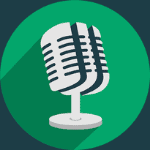If it feels like everyone’s listening to podcasts these days, you’re not imagining it.
According to Midroll, 67 million Americans listen to podcasts each month, a number up 45% from 2015.
Ever wonder if those podcasts make money? How do they keep going with episode after episode? Producing quality content is a lot of work. It’s only natural to want to find a way to make your podcast work for you.
In this guide I’ll cover three ways to monetize your podcast:
- Donations
- Dynamic Ads
- Growth & Exposure
Whether you’re producing a podcast to build authority, forge relationships, or as a creative outlet, this post is for you.
Set-up Donations On Patreon
The first step toward monetizing any creative outlet is to set up an account on Patreon.
Podcasts are no different. If you’re producing quality content, chances are high that at least some of your listeners will be willing to donate.
Patreon is a donation platform that makes it easy for fans or “patrons” to pay content creators for their work.
Unlike similar crowdfunding platforms such as Kickstarter or GoFundMe which are geared towards one-off projects, Patreon makes it easy to set up tiered monthly subscriptions, where subscribers can pay a monthly fee for access to exclusive content, early access to episodes, and other perks.
From one-time donations to paid subscriptions and sponsorships, Patreon lets you engage your audience and turn them into a viable revenue stream.
Editor’s note: Many of the podcast hosting platforms have a spot where you can insert your Patreon (or any) link in a “support this show” section:
A Brief Primer On Dynamic Ad-Insertion Platforms
In the old days, the only way to insert an ad into a podcast was to record and edit it into the actual audio file. The ad may be recorded separately and edited into the final production cut or mentioned directly by the host during the actual show recording.
Either way, these baked-in ads are permanent. A listener who downloads your podcast episode five years from now will hear the same ad that your listeners hear today.
Fortunately today, there is a better way—dynamic ad-insertion (DAI) platforms.
They use modern ad servers to allow you to dynamically insert ads anywhere in your podcast. Pre-roll, mid-roll, post-roll, you name it.
If a sponsor pays to run an ad in a given slot for a certain number of impressions, you can do that. Once the quota is met, you can swap the ad for another paying sponsor. Better still, you can leverage all your user analytics data, to serve custom ads to listeners based on their demographics.
To illustrate how this works, here’s what Erica Mandy, founder and host of the NewsWorthy has to say about sponsorships:
The cost of a podcast ad can vary greatly, but average industry CPMs (cost per 1,000 impressions/unique listeners) often ranges from $18-$50 and up, with $30 CPM most typical. I often work with podcast ad agencies but also occasionally work with sponsors directly. Agencies typically take 10-30% of ad revenue but cost nothing upfront. That said, there’s a new push for some podcasters to sell themselves as audio influencers and not be stuck in a radio-centric CPM model, especially for niche podcasts. The industry is still evolving.
Mandy works with an ad agency in addition to pitching herself to sponsors. Agencies can take anywhere from 10 to 30% of the ad revenue (but make nothing upfront).
When a listener downloads an episode of your podcast five years from now, you can be sure that ad is not only current, but relevant to that listener. A win-win for advertisers, content creators, and consumers.
Let’s dive into some popular dynamic ad-insertion platforms on the market.
Art19
Art19 is a relatively new podcast advertising platform that places freedom of expression front and center:
Everyone has the right to freedom of opinion and expression; this right includes freedom to hold opinions without interference and to seek, receive and impart information and ideas through any media and regardless of frontiers. – Article 19, The Universal Declaration of Human Rights
Art19 aims to be Spotify for podcasts. You must ask to join. As of this writing, they charge producers a monthly fee which can range from about $100 for a basic plan up to $700 for full-stack ad insertion depending on the services you need. The platform works best if you are producing your own ads.
Midroll
Midroll is the more established player in the podcast advertising game. It uses the CPM (cost per thousand impressions) model and provides access to ads from major companies such as HBO, Toyota, and Audible among others.
As you might have guessed, this platform commands large fees to match.
For example, Marc Maron’s WTF, which gets 550,000 downloads per episode, pays the following rates:
- 30 second pre-roll: $9,900
- 60 second midroll: $13,200
- 30 second post-roll: $5,500
Midroll’s podcasting roster includes big names such as The Bill Simmons Podcast which gets 500,000 per episode, and Neil deGrasse Tyson’s Startalk which nets $300,000 per episode.
Megaphone
Megaphone is a podcasting platform owned by the Panoply network. It specializes in targeted advertising, boasting over 60,000 demographic and intent-based segments. Advertisers have access to industry-leading data, powered by Nielsen’s Data Management Platform.
For publishers, it serves as a one-stop-shop for publishing, tracking user analytics, DAI, sales, and distribution. Megaphone serves as a bridge between advertisers and podcast publishers, helping both make the most of advertising dollars.
Networks To Increase Your Listenership And Exposure
Once you’ve set up some revenue streams, your next concern is how to grow them. The key to that is to understand your target audience and set yourself up as a gatekeeper.
Jay Connor, producer and co-host of The Extraordinary Negros, recommends:
Position yourself as a gatekeeper. When sponsors and corporate entities realize that you’re the gateway to a specific demographic or community, they’ll have no choice but to seek you out in order to expand their business model.
There are a number of networks you can join to boost your podcast’s exposure. Let’s take a quick look at some major players.
Panoply
Panoply is a podcast network created by the minds behind Slate’s popular award-winning audio network.
The platform relies on Megaphone’s suite of marketing, sales, and audience development services for podcast producers and media brands.
The network includes programming from HBO, New York Times, and HuffPo among others. You need at least 50,000 downloads per episode before you can even be considered to join.
Gimlet
Gimlet Media is a Brooklyn-based digital media company and podcast network that sees over twelve million downloads per month by listeners from nearly 190 countries around the globe. You may already know them as the brains behind hit podcast StartUp which is hosted by Gimlet cofounder Alex Blumberg.
Gimlet’s specialty is brand partnerships. Their in-house media team Gimlet Creative helps produce integrated ad campaigns and branded shows, such as eBay’s Open for Business and Blue Apron’s Why We Eat What We Eat. Google, Squarespace, Microsoft, and Spotify are just some of the names among their featured advertising partners.
VoiceAmerica
VoiceAmerica is a mainstay in the world of online talk radio. Their network delivers content to millions of listeners across more than 140 countries worldwide in eight branded channels:
- Variety
- Health & Wellness
- Influencers
- Sports
- Business
- Empowerment
- Women
- Kids
VoiceAmerica assigns an executive producer to produce your show and the promos for it, or you can submit your show to go up on their RSS feed; their services are fee-based. Your show can have a regular time slot and be distributed live on their network.
Wondery
Wondery bills itself as a network of storytellers, and they’ve got the content to match:
- Dirty John, the hit true-crime podcast from the LA Times, breached 20 million downloads earlier this year.
- American History Tellers, which chronicles the stories that made America from the Gold Rush to the Space Race, has been downloaded more than 3 million times.
If you’ve got a compelling story you’d like to tell, Wondery has the credentials, advertising representation, and reach you need to increase your listenership and exposure.
Good Content Is The Engine Of Monetization
I like to think of a podcast as a vehicle for carrying your message to the masses. It takes a powerful engine to build an audience, and quality content is that engine.
As Jessica Kupferman, podcast revenue consultant, recommends:
If you want to monetize, audience growth is your first job. Concentrate on your audience before seeking sponsors because that’s your product to sell to advertisers. The power to connect with the host is the power of podcast advertising. It really is about the audience demographic for sponsors. When preparing a pitch deck for your podcast, be sure to sell the medium first. Your potential sponsors may never have advertised on a podcast before. You need to introduce them to the value of the medium.
If good content is the engine, how do you fuel it to keep it running so that you can keep producing quality work day after day? That’s where advertising, sponsorships, and donations come into play.
Now that you’ve seen some of the major ad platforms and content distribution networks that are out there you’re ready to take your first steps towards monetizing your podcast.
Want to dive deeper? Learn some other ways podcasts make money.





